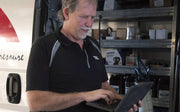
Monitoring for Compressed Air Systems
About Our Monitoring for Compressed Air Systems
We offer three primary types of monitoring and testing for compressed air systems.
Flow Meters are a cost-effective and easy way to measure actual compressed air usage. They provide insight to help you save energy and manage your compressed air use. The device installs in minutes and connects to the cloud via wifi.
Remote Monitoring via simple cloud-based air compressor monitoring that displays a visual window into the control and performance as real-time data. A remote monitoring system will provide analytics and insights at the push of a button that lead to savings and control of energy costs.
Lab Testing of Compressed Air ensures that the air is not a source of contamination in a system that is expected to produce high-quality and safe products. Serious contamination can be avoided through regular testing and the proper assessment of the compressed air system. The ISO 8573 standard supports accurate testing of the major contaminants in compressed air: particles, water, oil and microorganisms.

Get in Touch Today
We are here to serve your compressed air system needs 24/7/365. Call or click today!
FAQ
Why do I need compressed air monitoring?
Compressed air monitoring gives you important information that you can use to improve the energy efficiency and performance of your compressed air system. A monitoring program gives you baseline data about air use and energy expenditures that you can use to optimize your compressed air system and detect deviations in performance that may indicate an emerging problem. Compressed air monitoring can help you:
- Determine patterns in air usage across shifts, days, weeks and seasons.
- Detect sudden increases in air use that may indicate new leaks in the system or an unexpected demand surge.
- Properly size equipment and make decisions about upgrades and reconfiguration.
- Allocate energy costs.
- Improve early detection of problems with the compressor so they can be addressed promptly.
- Ensure an adequate supply of clean, dry, reliable compressed air.
What is a compressed air flow meter?
A flow meter is an instrument used to measure linear, nonlinear, mass or volumetric flow rate of a liquid or a gas through a tube or pipe. In a compressed air system, a flow meter is used to measure the flow of compressed air coming out of the compressor. Inline flow meters may also be used at other points in the compressed air system to monitor airflow through different parts of the distribution system. Some flow meters will measure pressure and temperature in addition to airflow.
Most compressed air flow meters do not measure the volume of air passing through directly. Instead, they measure the mass of air flowing through the device per unit of time. This measurement is converted to a volume measurement in cubic feet per minute (CFM).
What is the ISO 8573 quality standard for compressed air?
ISO 8573 is an international standard for compressed air quality which specifies purity classes for air in terms of concentration of particulate matter, oil and water. It also provides recommended testing methods for compressed air laboratory analysis. The standard is widely recognized around the globe, including the US, UK and EU.
Compressed air is classified into purity levels from 0 (highest purity) to 9 (lowest purity). (Anything of lower purity than class 9 is simply labeled “X”.) The different purity classes of compressed air are defined by:
- Particulate concentration, defined by maximum number of particles in different size ranges (0.10 - 0.5 microns, 0.5 - 1.0 micons, and 1.0 - 5.0 microns) per m3 for classes 0 - 5 and by total mass (mg/m3) for classes 6 and up.
- Water concentration, measured by vapor pressure dew point for classes 0 - 6 and by mass of liquid water (g/m3) for classes 7 and up.
- Oil concentration (mg/m3) for total liquid, aerosol and vapor.
ISO 8573 does not set specific purity classes for gases or microbiological contaminants, but does mention gaseous contaminants including CO, CO2, SO2, NOX and hydrocarbons (C1 - C5). Laboratory testing may include both microbial and gaseous contaminants. The type of testing required, and the purity class required for compressed air, will depend on how the compressed air is being used. Compressed air used for food and beverage production, pharmaceuticals, medical applications and breathing will require higher purity levels than air used to run pneumatic tools. ISO 8573 sets purity classes for various air applications.
Fluid-Aire Dynamics can help you determine the required purity level and appropriate compressed air laboratory testing for your application.